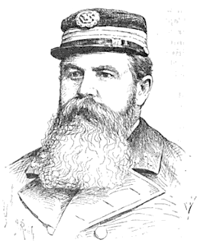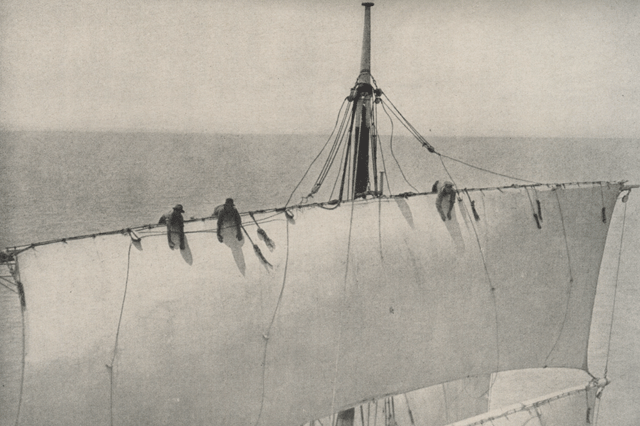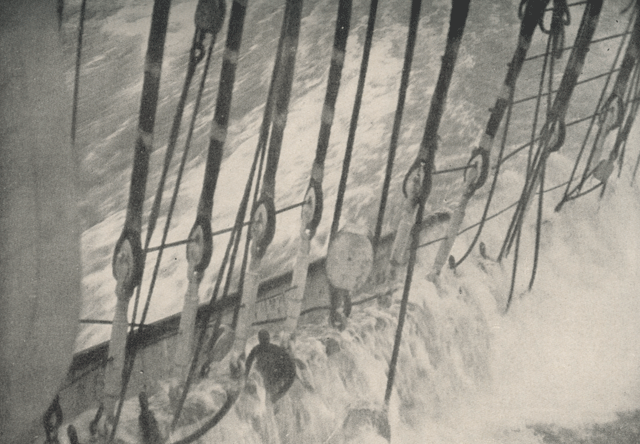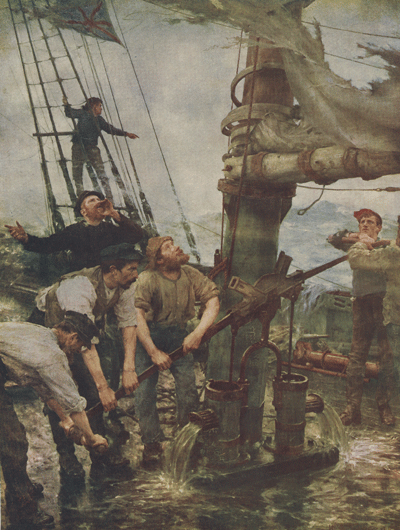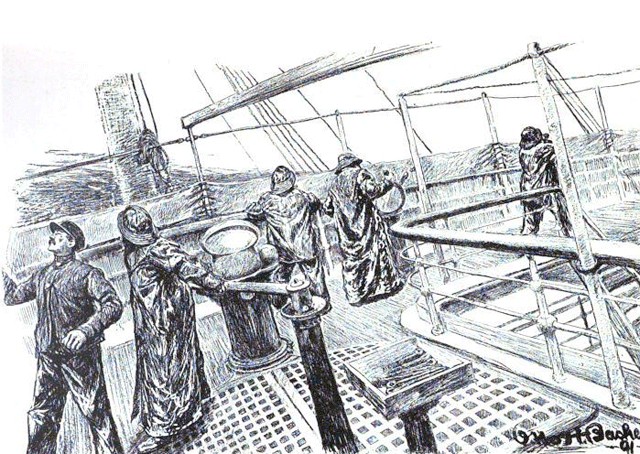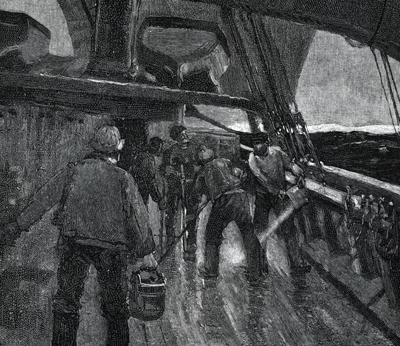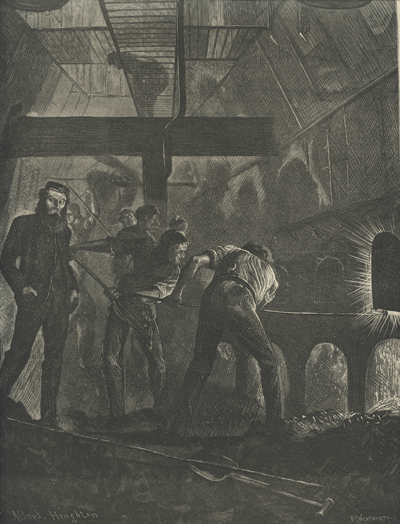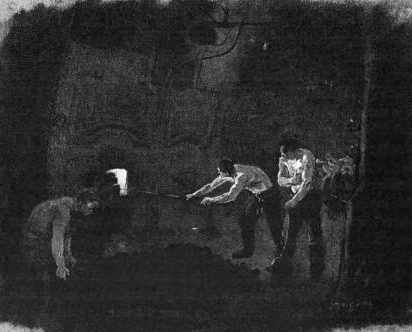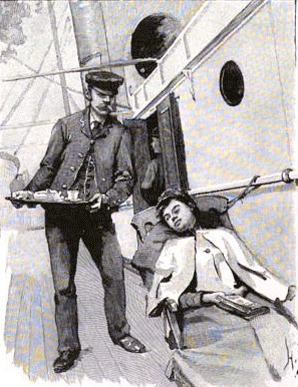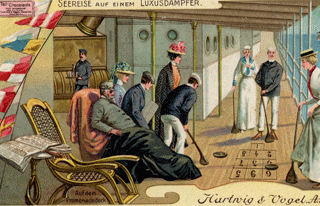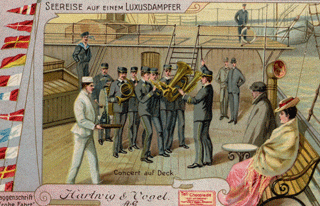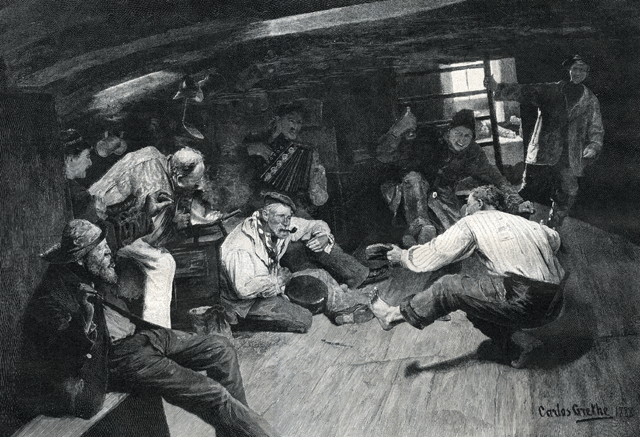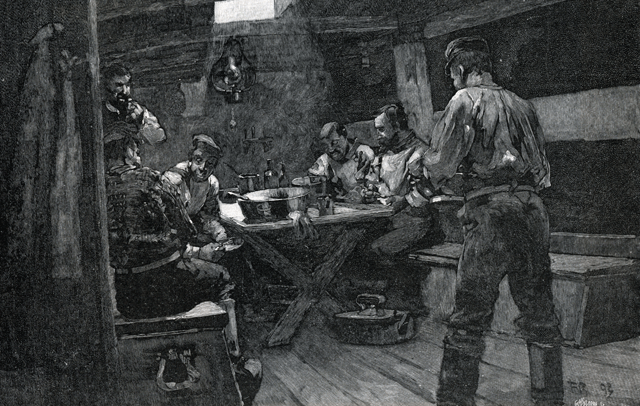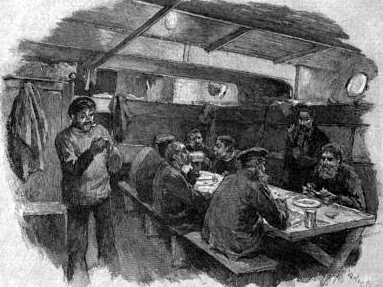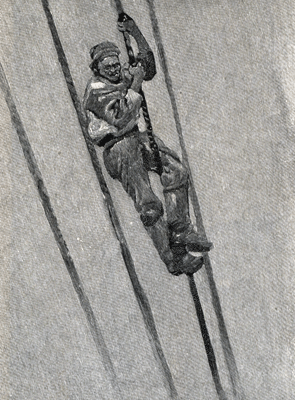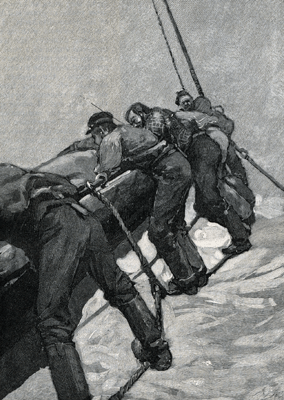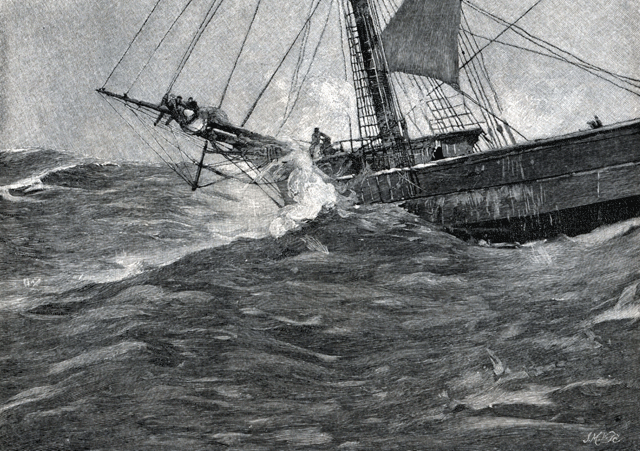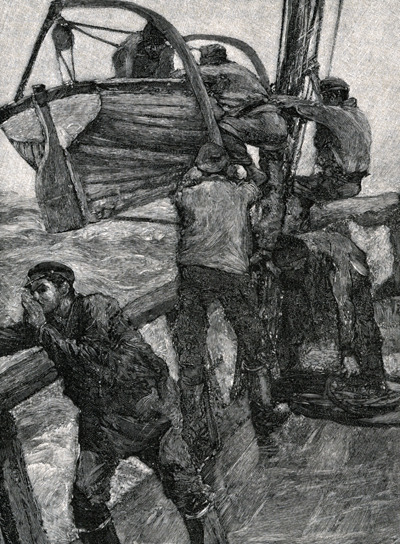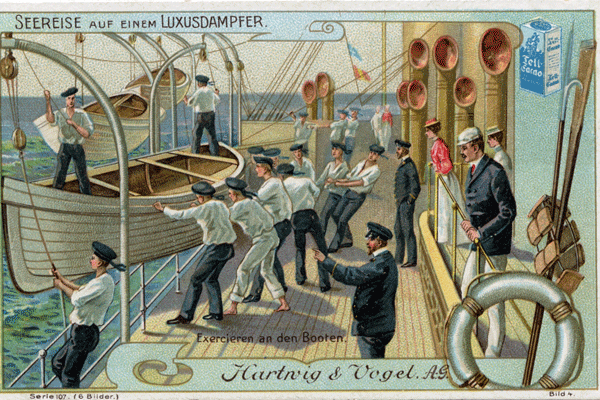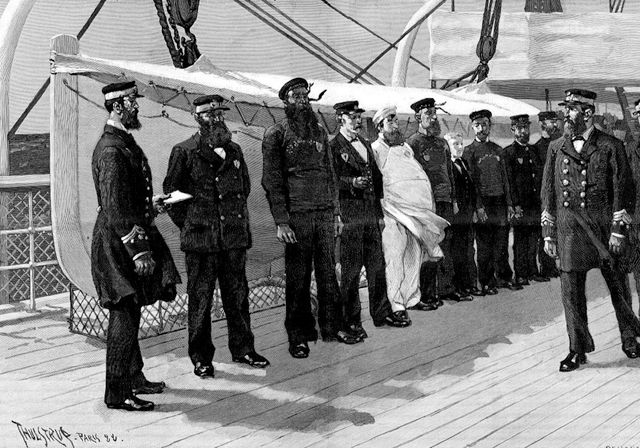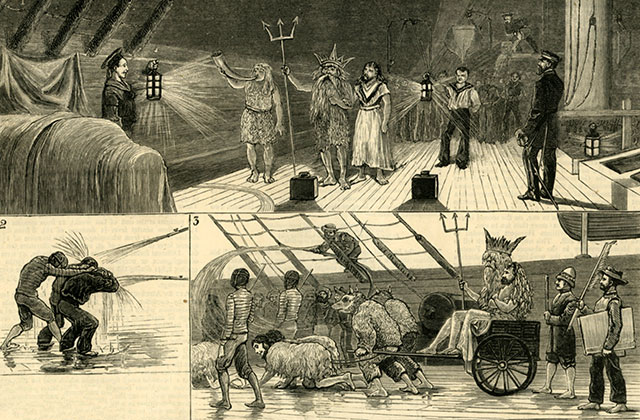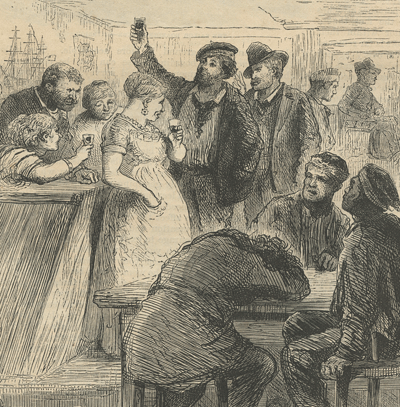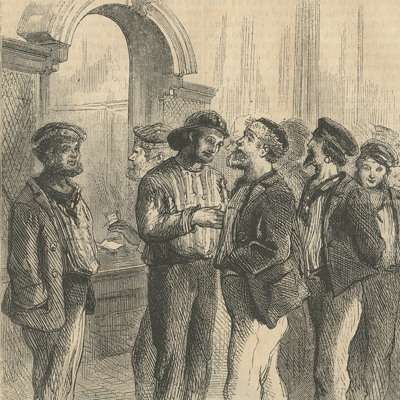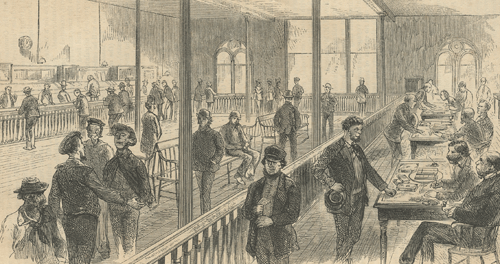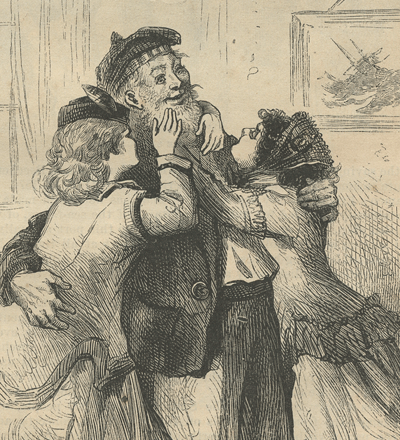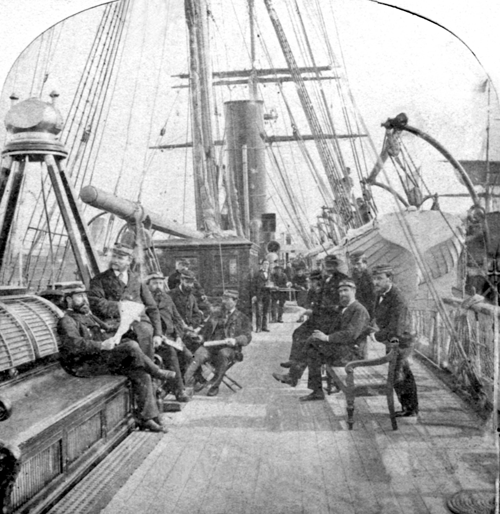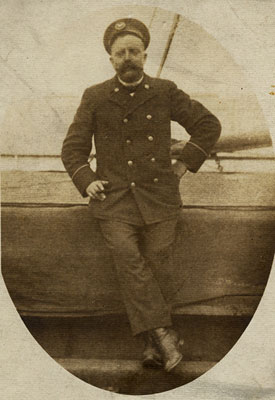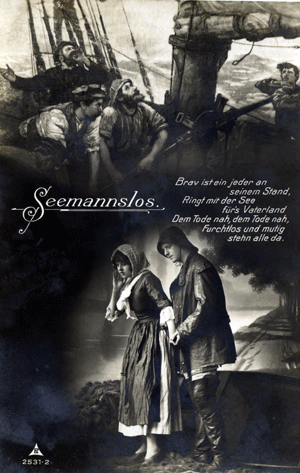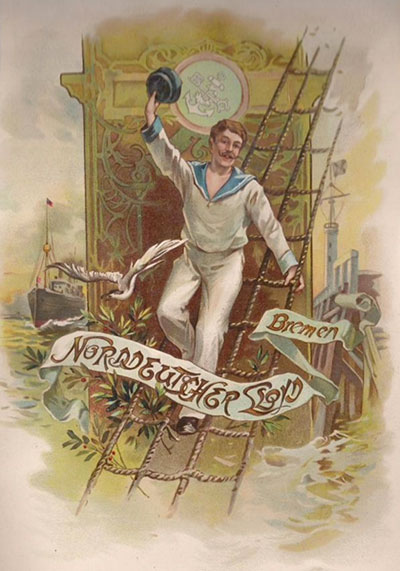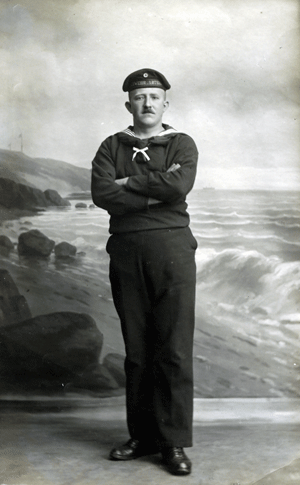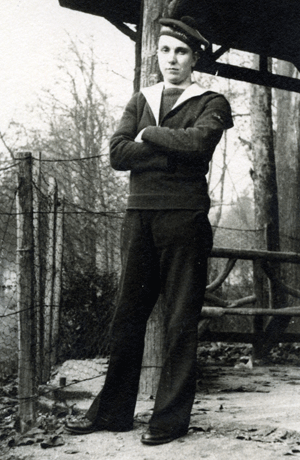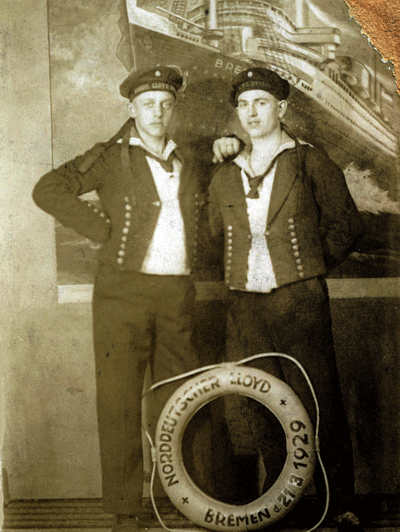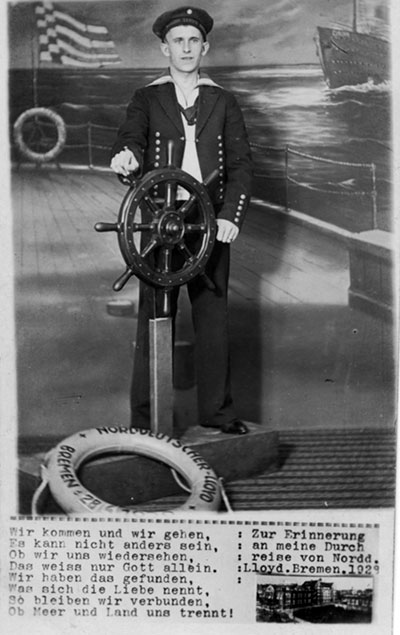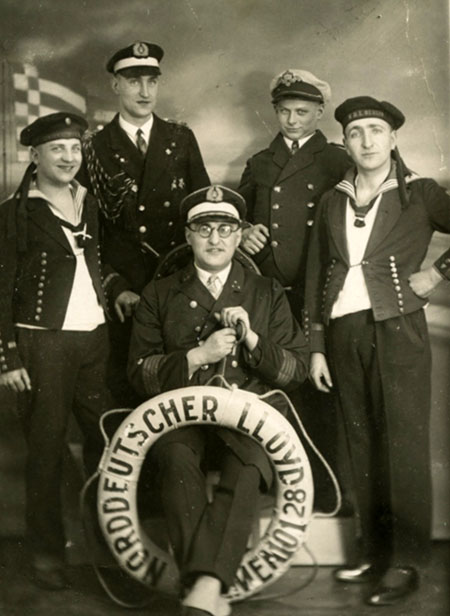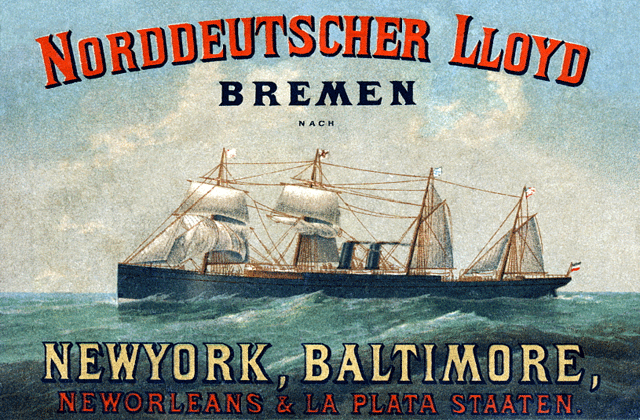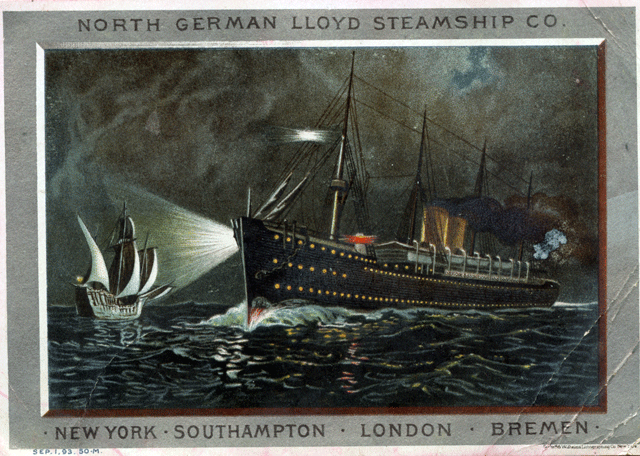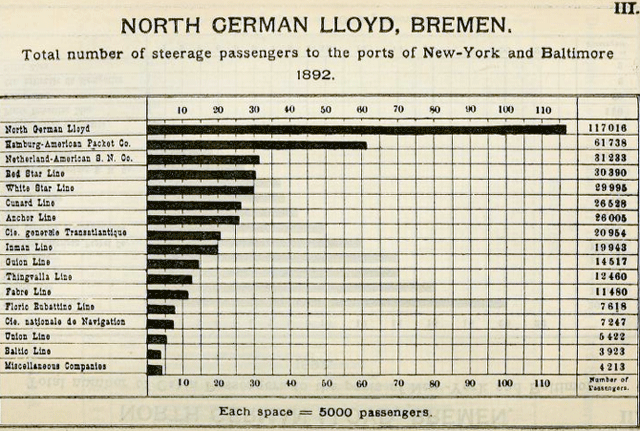The North German Lloyd (Norddeutscher Lloyd) Bremen/Bremerhaven
The transatlantic steamer line North German Lloyd (Norddeutscher Lloyd) of Bremen was founded in 1857 and consisted of three steamers running to England. Four screw steamers were subsequently purchased to make the transatlantic run between Bremen and New York. The first of these screw steamers made her maiden voyage in June 1858. Initially the main business of the North German Lloyd was the transportation of emigrants from Germany to the United States. However, the returning cargo was more uncertain. As a consequence they started lines to The West Indies and South America. In addition to the press of emigration other changes had occurred after 1870 with encouraged an increase in shipping. These included the development of steam ships, commercial and navigational treaties, the reduction in pirates, and the opening of East Asia.
In 1870 the Bremen merchant marine was made up of 27 steamers. By 1898 it was made up of 259 steamers. In 1872 the Norddeutscher-Lloyd started two weekly steamers from Bremen to New York, and a weekly steamer to Baltimore, and also extended its connections with South America.
"As is so often the case, the success of this great company is said to be mainly due to one man, the late Mr. H. H. Meier, who for many years was its life and soul. He succeeded in amalgamating the various steamship companies then existing and forming out of them this company, which has gradually become one of the greatest steamship companies in the world. In June, 1858, the New York line was opened via Southampton, with the screw steamship Bremen (318 x 40 x 26), 2674 tons, followed by the New York, Hudson and Weser, all built by Caird & Co., of Greenock. These boats were so satisfactory that for a great many years they confined themselves to this yard. In all, Caird & Co. are said to have built some forty ships for the company. In 1862 and 1863 the Hansa and America, followed by the Hermann, Deutchland, and Union, were added to the line, all built by Caird & Co. In 1866 it became necessary to establish a weekly line to New York, and the following year the fleet numbered fourteen steamers, of which eight were in the New York trade and six in the English. In 1869 the company extended their operations to New Orleans, and in 1870 to the West Indies; in 1875, to Brazil and the River Plate. Most of their boats have been called after the principal rivers of Germany. A printed return shows that in 1874 the average weekly passages westward from Southampton of the company's boats, Donau, Moselle, Hermann, Hansa, Weser, Rhein, Main, America, Oder, Neckar, Deutchland, Hohcnstauffen and Hohenzollem, was 11 days 13 hours, the Main making the quickest in 9 days 14 hours 20 minutes. Eastward, the average for the same year was only 10 days 8 hours 58 minutes, the Moselle making the quickest in 9 days 8 hours and 50 minutes."Most German ships were made up of entirely German crews with an occasional Scandinavian or Dutchman. Most of the German seamen came from the north near the coast and spoke a North German dialect.The history of North Atlantic steam navigation: with some account of early ... By Henry Fry, 1896
The German seaman had a reputation as being well disciplined, hard working, and sober.
"Nor does the German seaman disdain a small refreshment, but his self-respect, and higher degree of cultivation, keep him from degrading himself in a similar manner, although of course there are exceptions. He has had his pleasure, and has visited the neighbourhood and everything worth seeing, so he is content, and spends the rest of his money in keepsakes, and curiosities for his relations; he is a German and thinks always of the dear ones at home."German Merchant ships were bound to transport home any German seaman found in need in a foreign country.United Service Magizine, 1881
The North German Lloyd Fleet in 1868
According to Norway Heritage the North German Lloyd Fleet in 1868 included:
S/S America 1862
S/S Baltimore 1868
S/S Berlin 1867
S/S Bremen (1) 1858
S/S Deutschland 1866
S/S Hansa (1) 1861
S/S Hermann 1865
S/S Main (1) 1868
S/S New York 1858
S/S Rhein (1) 1868
S/S Union 1866
S/S Weser (2) 1867
In 1868 North German Lloyd ships were carrying passengers, mail, money and cargo.
"American Mails. - Southampton Sept. 15. - The North German Lloyd screw steamship Deutschland, Captain H. Wessels, arrived this morning, with mails of the 3rd inst., from New York, 110 passengers, $104 907 in specie for England, and 1,000 tons of cargo for Bremen. Light easterly winds, with heavy swell, and generally fine weather, were experienced on the passage. On the 12th, at 6 p.m., in lat. 49 41 N, long. 23 43 W., the Deutschland spoke the English bark Egmont. The North German Lloyd screw steamship Union, Captain H. J. von Sauten, sailed hence this afternoon for New York, with English, French, and German mails, 158 cabin passengers, jewelry from Havre value 125,000f., and a full cargo of general merchandize. The new steamer Rhein, belonging to the same company, left Greenock for Bremen on Sunday last, and will sail from Southampton on the 6th proximo, on her first voyage to New York."The Latter-Day Saints' millennial star, Volume 30,1868
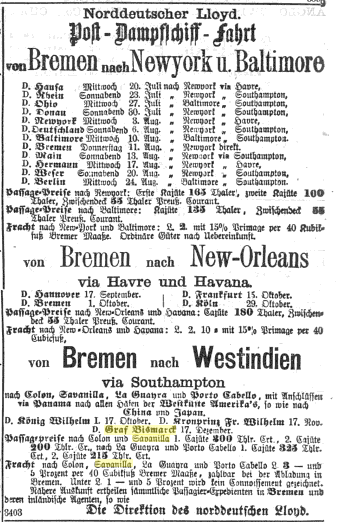
In July and August 1870 the following ships were advertised as running from Bremen via Southampton to New York: Rhine, Donau, Deutschland, Main, Weser.
In July and August 1870 the following ships were advertised as running from Bremen via Havre to to New York: Hansa, New York and Hermann.
The Bremen was going directly from Bremen to New York.
The Ohio, Berlin and Baltimore were going Bremen via Southampton to Baltimore.
The Hanover, Bremen, the Frankfurt and the Koln were running from Bremen via Harve and Havana to New Orleans.
The Konig Wilhelm I, the Kronprinz Fr. Wilhelm and the Graf Bismarck went from Bremen via Southampton to the West Indies: Colon, Savanilla, Curacao, La Guayra, Porto Cabello with connection via Panama to the West Coast ports of America and on to China and Japan.
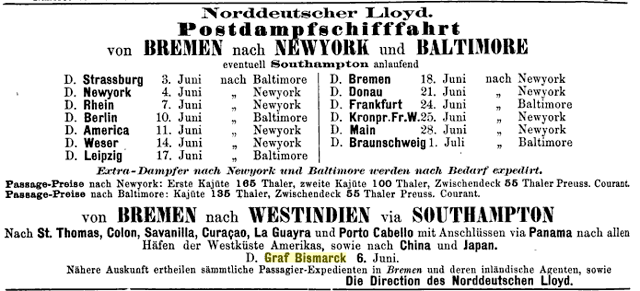
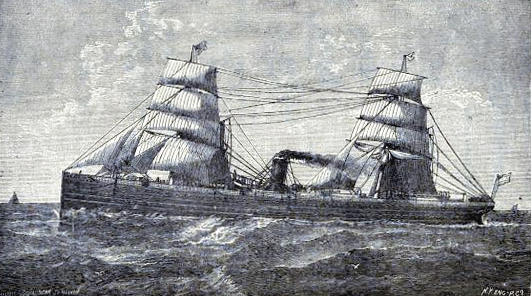
My ancestors and their relatives were Merchant Seamen who sailed out of Bremen between the 1830s and the early 1870s. Consequently my focus is on the Bremen ships of that period - specifically the ships they actually served on.
The AMERICA 1863-1894
The AMERICA was on the Bremen to New York Route from 1863 to 1894.
J. Berend Peterman was on the AMERICA from September 30, 1872 to about May 12, 1873. See Berend Petermann at Sea for details of crossings for this ship.
Herman Blanck served on the AMERICA from November 9 1870 to unknown. See Hermann Blank At Sea
The German Lloyds new steamship AMERICA sailed from Southampton on the 27th of May, 1863 arrived June 7, 1863.
AMERICA / ORAZIO 1862 The AMERICA was a 2752 gross ton ship, length 318ft x beam 40ft, clipper bows, one funnel, three masts (rigged for sails), iron hull, single screw and a speed of 11 knots. Accommodation for 76-1st, 107-2nd and 480-steerage class passengers. Built by Caird & Co, Greenock, she was launched for North German Lloyd, Bremen in Nov.1862. Her maiden voyage started on 25th May 1863 when she left Bremen for Southampton and New York. In 1871 she was fitted with new engines and on 27th Jan.1894 commenced her last round voyage from Bremen to New York and Baltimore. Sold to Italy in 1894, she was renamed ORAZIO and was scrapped the following year. [North Atlantic Seaway by N.R.P.Bonsor, vol.2,p.545]
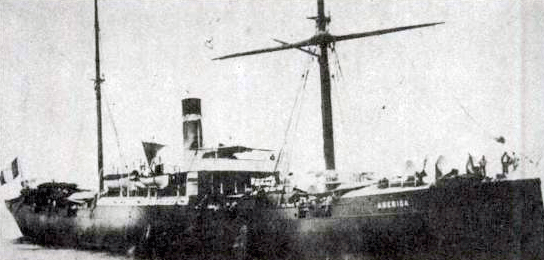
To see an additional image of the AMERICA go to The Palmer List of Merchant Vessels
1873: Arrived Steam-ship America (Ger.), Bussins, Bremen March 13, Southampton 16th with mdse and 304 passengers to Oelirich & co, March 29, 1873 (NYT)
Hermann Blank served on the BALTIMORE from January 25, to May 1869. See Hermann Blank At Sea
Sailings between January 1869 and May 1869 per Abfahrtsdaten von Auswandererschiffen (European's list the day then the month)
- 01.02.1869, Baltimore, Nordd. Lloyd, from Bremen, Vöckler, W. to Baltimore, 59 passengers
- 07.04.1869 Baltimore Nordd. Lloyd, from Bremen Vöckler, W. to Baltimore, 711 passengers
Statistics on the Baltimore:
BALTIMORE 1868 The BALTIMORE was built in 1868 by Caird & Co, Greenock for North German Lloyd of Bremen. She was a 2,321 gross ton ship, length 285ft x beam 39ft, clipper stem, one funnel, two masts (rigged for sail),iron construction, single screw and a speed of 10 knots. There was passenger accommodation for 84-1st and 600-3rd class. Launched on 3/8/1867, she left Bremen on her maiden voyage to Southampton and Baltimore on 1/3/1868. On the night of 22-23/5/1872 she was in collision off Hastings with the Spanish vessel LORENZO SEMPRUN, was beached, and towed to Southampton for repairs. In 1881 her engines were compounded by AG Weser, Bremen, and on 10/10/1883 she commenced her last Bremen - Baltimore crossing. She was subsequently used for the Bremen - S.America service. Her final voyage started on 30/12/1893 and the following year she was scrapped. [North Atlantic Seaway by N.R.P.Bonsor, vol.2,p.545-6]Building of the Baltimore
The new screw steamship Baltimore, 2200 tons, built by Messrs. Caird and Co., for the North German Lloyd's, for their new line of Bremen and Baltimore traders, which has been lying over at Gareloch for the last two months, was towed back to the Victoria Harbour, Greenock, a few days ago. Her shaft, which has been made in Germany, having arrived, she will now be completed.The Initiation of the Route between Baltimore and BremenEngineering, 1867
On the 23d of March, 1869, the steamship Baltimore, the pioneer vessel of the North German Lloyd line between Baltimore and Bremen, arrived in the harbor, and four days later the commercial interests, the civic authorities, and the population in general, celebrated the establishment of regular steam communication between Baltimore and Europe with an elaborate demonstration of their gratification.Wreck of the BALTIMORE off Hastings 1872.Baltimore: its history and its people, Volume 1 By Lewis Historical Publishing Co, 1912
The North German Lloyd's steamship Baltimore, which arrived at Southampton on the 22d ult. from Baltimore for Bremen, and subsequently sailed for her destination, on the following night came in collision, off Hastings, with the Spanish steamship Lorenzo Semprum. The Baltimore had a large hole stove in her hull, and the fires were soon extinguished, not however before the steamer had been run aground. The crew and passengers were all landed in safety.The Friend, 1872

The steam-ship Baltimore trading between Bremen and Baltimore was hit by the Spanish steamer Lorenzo Semprun in the Channel near Hastings about midnight May 22, 1872. She had departed Baltimore on May 9th. Captain Deetjan of the Baltimore, having determined that there was a large hole in the starboard bow, turned her towards shore "guided by the lamplights on the Marine Parade at Hastings". Rockets were fired which were seen by the coastguard who immediately came to the rescue. Taking on water quickly she ran aground about a third mile from the Marine Parade, her head having gradually sank. There were 130 passengers and 80 seamen on board. All were safely brought to shore. All of the luggage was salvaged. The forward compartment was filled with water. The ship lay in about 8 feet of water at low tide and many people went out to the Government House coastguard station to take a look. The Baltimore was towed to Southampton for repairs.
She had been on her way from America to Bremen "Laden with tobacco, molasses and lard". On setting sail from Baltimore her captain was named Fisher. It appears he died at sea.
"Captain Fisher had died on the voyage, and Mr. Deetjan was in command. She had put in at Southampton and landed her English passengers, on the Wednesday, leaving Southampton at four o'clock that afternoon. The Spanish steamer, on her way from Aalsund to Santander with a cargo of fish, received great damage from the collision, but was enabled to reach Southampton on the the Thursday afternoon."
Melusine Erxmeyer and her one month old infant (born at sea) arrived in Hoboken on the Bremen on December 26, 1872. See Melosine Erxmeyer Blanck
ArrivedJohn Lehman, who would later marry Melusine's sister, Julia, was a steward on the BREMEN from August 1872 until he deserted ship in New York in February 1873. See Julia Erxmeyer Lehmann TietjenSteamship Bremen, (Ger.) Ladewigs, Bremen. Dec. 7, and Southampton 10th, with mdse. and passengers to Oelriche & Co.
New York Times, December 26, 1872
Sailings between August 1872 and February 1873 per Abfahrtsdaten von Auswandererschiffen (European's list the day then the month)
- 20.08.1872, Bremen, Nordd. Lloyd, Bremen, Captain Gardewigs, New York 459 passengers
- 03.09.1872, Bremen, C.L. Brauer & Sohn Captain Hellmers, Galveston 64 passengers
- 16.10.1872, Bremen, Nordd. Lloyd, Bremen Captain Ladewigs, New York 502 passengers
- 07.12.1872, Bremen, Nordd. Lloyd, Bremen Captain Ladewigs, New York 269 passengers
- 25.01.1873 , Bremen, Nordd. Lloyd, Bremen Captain Klugkist, New York 184 passengers
The Bremen was listed in violation of overcrowding laws on vessels arriving in the port of New York in April 1872. She was carrying 749 passengers - an excess of 150 passengers. (Senate 1873 Steerage Passengers on emigrant vessels). The Bremen arrived April 15, 1872 and according to the ship's manifest was listed with 25 cabin passengers and 817 steerage passengers.
The Bremen was the first of the North German Lloyd ships to make a transatlantic crossing between Bremerhaven and New York. She left Bremerhaven under the command of Captain Wessels late in the evening on June 19, 1858 with 1 first class cabin passenger, 21 second class cabin passengers and 96 steerage passengers. According to the Manifest she arrived in New York on July 6, 1858.
In 1858 three more steamships were added to the line: the Hudson, The Weser and the New York.
BREMEN 1858 The BREMEN of 1858 was a 2,674 gross ton ship, built by Caird & Co, Greenock, Scotland for Norddeutscher Lloyd of Bremen. Her details were - length 97,53m x beam 11,88m (320ft x 39ft), she had a clipper stem, one funnel, three masts (rigged for sail), iron construction, single screw and a speed of 10 knots. There was accommodation for 160-1st, 110-2nd and 400-3rd class passengers. Launched on 1st February 1858, she sailed from Bremen on her maiden voyage to New York on 19th June 1858. She continued on this service except for six months repair in 1860, when she fractured her propellor shaft. On 5th November 1873 she started her last voyage from Bremen to Southampton and New York, and in 1874 was sold to Edward Bates of Liverpool who had her engines removed and used her as a sailing vessel. On 16th October 1882 she was wrecked on the South Farralone Islands, California. [North Atlantic Seaway by N.R.P.Bonsor, vol.2,p.544]Build by Caird & Co., Greenock, Scotland.
Tonnage: 2,551. Dimensions: 321' x 39'. Single-screw, 10 1/2 knots. Inverted engines. Three masts and one funnel. Iron hull. Clipper bow. Passengers: 150 cabin, 800 third. Note: Pineer steamship of the North German Lloyd. Maiden voyage: Bremen-New York, June 19, 1858. Made her last voyage for line in November 1873. Sold to British shipowners in 1874 and converted to sail. Wrecked of San Francisco in 1882. Running mates: New York (identical), Hudson and Weser.
From Passenger Ships of the World Past and Present by Eugene W. Smith, copy of ships information provided by The Steamship Historical Society of America.
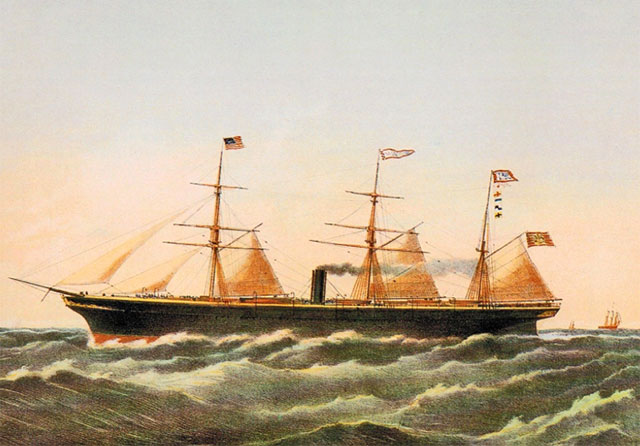
Frederick Erxmeyer served on the DEUTSCHLAND September and October 1868 and November to December 1868. See Freidrich Erxmeyer at Sea
Sailings between September and December 1868 per Abfahrtsdaten von Auswandererschiffen (European's list the day then the month)
- 26.09.1868 Deutschland Nordd. Lloyd, Bremen Wessels, H. New York 631
- 14.11.1868 Deutschland Nordd. Lloyd, Bremen Wessels, H. New York 475
The DEUTSCHLAND
DEUTSCHLAND 1866 2,800 gross tons, length 325ft x beam 40ft, clipper bows, one funnel, two masts, iron hull, single screw, speed 11 knots, accommodation for 60-1st, 120-2nd and 700-3rd class passengers. Launched 29th May 1866 by Caird & Co, Greenock for North German Lloyd, Bremen, she started her maiden voyage on 14th Oct.1866 when she left Bremen for Southampton and New York. On 6th Dec.1875 she was wrecked off Kentish Knock in the Thames Estuary with the loss of 157 lives. [North Atlantic Seaway, vol.2,p.545 by N.R.P.Bonsor]

To see an additional image of the DEUTSCHLAND go to Palmer List of Merchant Vessels
The Erxmeyer brothers, Fredrick and Henry, and their brother-in-law, Johann Leham sailed on the Donau. Fred Erxmeyer was on the Donau from December 1868 to August 1, 1871. Henry Erxmeyer was on the Donau from April 1871 to August 1. 1871. Johann Lehman was on the Donau starting in July 1871. I do not know when he left this ship.
Fred Erxmeyer's wife, Charlotte Erxmeyer emigrated on the Donau in 1871 Charlotte Erxmeyer, age 25, traveling with Charlotte Erxmeyer, age 7 months, and Marie Erxmeyer, age 9 years arrived on September 4, 1871 aboard the S.S. Donau from Bremen to New York (Donau Ship Manifest) Sailings for the Donau were not listed in 1868 per Abfahrtsdaten von Auswandererschiffen. Sailings from January 1869 to July 1871 were as follows. (European's list the day then the month).
- 16.01.1869 Donau Nordd. Lloyd, Bremen Ernst, G. New York 143
- 10.04.1869 Donau Nordd. Lloyd, Bremen Ernst, G. New York 707
- 29.05.1869 Donau Nordd. Lloyd, Bremen Ernst, G. New York 730
- 10.07.1869 Donau Nordd. Lloyd, Bremen Ernst, G. New York 477
- 28.08.1869 Donau Nordd. Lloyd, Bremen Ernst, G. New York 749
- 23.10.1869 Donau Nordd. Lloyd, Bremen Ernst New York 732
- 29.01.1870 Donau Nordd. Lloyd, Bremen Ernst, G. New York 220
- 19.03.1870 Donau Nordd. Lloyd, Bremen Ernst New York 643
- 30.04.1870 Donau Nordd. Lloyd, Bremen Ernst New York 759
- 11.06.1870 Donau Nordd. Lloyd, Bremen Ernst New York 479
- 22.10.1870 Donau Nordd. Lloyd, Bremen Ernst New York 676
- 24.12.1870 Donau Nordd. Lloyd, Bremen Ernst New York 95
- 04.03.1871 Donau Nordd. Lloyd, Bremen Ernst New York 283
- 15.04.1871 Donau Nordd. Lloyd, Bremen Ernst New York 730
- 27.05.1871 Donau Nordd. Lloyd, Bremen Ernst New York 711
- 15.07.1871 Donau Nordd. Lloyd, Bremen Ernst New York 714
- 26.08.1871 Donau Nordd. Lloyd, Bremen Ernst New York 791
DONAU (1) 1868
The DONAU was 2,896 gross tons, length 332ft x beam 40ft, clipper bows, one funnel, two masts, iron hull, single screw, speed 13 knots, accommodation for 60-1st and 700-3rd class passengers. Built by Caird & Co, Greenock, she was launched on 17th Oct.1868 for North German Lloyd, Bremen. Her maiden voyage started 16th Jan.1869 when she left Bremen for Southampton and New York and her last Bremen - New York sailing started on 16th Jan.1887. On 25th Sep.1889 she commenced her last Bremen - Baltimore voyage and was sold to H. Bischoff, Bremen on 21st Oct.1889. Rebuilt as a freighter, she sank on 16th Mar.1895 after catching fire in the North Atlantic en route Hamburg - Philadelphia. All aboard were saved by the British ship DELAWARE. [North Atlantic Seaway by N.R.P.Bonsor, vol.2,p.546] [Norddeutscher Lloyd, Bremen, vol.1 by Edwin Drechsel]
The Little Western,
a 16 feet fishing dory, sailed from East Gloucester on June 12, 1880 bound for England and
manned by George P Thomas and Fredrick Norman. She ran into several steamers
who thought she was in distress.
Coming upon the dory Little Western the Donau was delay an hour to
determine that everything was okay.
The commander of the North German Lloyds steamship Donau, in a letter to the newspapers, complained of an hour's delay to his vessel, caused by his supposition that the dory Little Western contained shipwrecked persons. He says the experiment of crossing the Atlantic in small boats is now only a sporting venture, made for money and notoriety. Every shipmaster is morally obliged to investigate small boats, to discover whether they are cases of distress. It is to be feared that some shipmasters, after being fooled in the way he was in regard to the Little Western, may not pay attention to the cases of actual urgency if these sea tramps continue to cross the ocean.Frank Leslie's popular Monthly Vol.12, 1881
The steamship Donau sailed to day for Europe with $1,051,200 in specie, including $5,000 for Harve. The whole amount was in Mexican dollars The Evening Telegram September 23, 1869 Philadelphia.
The steamship Donau arrived in New York from Bremen, January 10, 1871.
The steamship Donau from New York touched at Southampton, April 4, 1871.
Freight on the SS. Donau
Exports cleared for foreign ports indicate the following shipments on the Donau.
- March 27, 1871 Donau for Bremen -
50 pks Fur and Skins, 6 cases Oil Peppermint, 300
bbls Resin, - hhds Tobacco, 2 cases Cigars,
12 boxes Essential O--,
50 bales Istle*, 7 bbls Guts, 500 boxes Extract, 39 pl--,
Machinery, 632 bales Cotton, 69 Whalebones -- bbls Syrup, 292
bbls Shoe-pegs, 6 bbls Flour, 5 ke-- Caviar, March 27, 1871
*a strong fiber from tropical American plants used for making rope.
- August 7, 1871 Donau for Bremen 6 bales Furs, 555 tcs Lard, 4,399 bushels Wheat,
326 bbls Resin, 223
hhds. Tobacco, 1,020 seroons Tobacco, 13,694 bushels corn, 249 boxes Cheese.
Also 2,003 bags of Rio Coffee "by the Donau, were sold on private terms"
- June 3, 1872
Donau fromBremen 3 cases Bromide Potass, 114 pks Aricurtural
Implements, 136 bales of Tobacco, 37 pks Furs, 57 cases Tobacco,
8,955
bushels Corn, 100 boxes Spermaceti 4 pks Senna, 564
bbls Resin, 5 pks Hardware, 58 hhds Tobacco
J. Berend Peterman was on the GRAF BISMARCK August 4, 1871 to February 5, 1872 and again from February 5, 1872 to July 25, 1872.
J. Berend Petermann made two tours of duty on the Graf Bismarck serving from August 1871 to July 1872. Johann Leham made one tour of duty on the Graf Bismarck serving from February 1872 to July 1872.
Sailings for the Graf Bismarck were not listed in 1871 and most of 1872 per Abfahrtsdaten von Auswandererschiffen. The first listing for 1872 was for August.
The Graf Bismarck of the Bremer line was launched at Greenock, Scotland on November 11, 1870.
In 1873 the Graf Bismarck's route was:
To the West Indies via Southampton to St. Thomas, Colon, Savanilla, Curacao, La Guayra, Porto Cabello with connection via Panama to the West Coast ports of America and on to China and Japan.
From New York March 06, 1874
Great Anxiety is expressed for the safety of the steamer Graf Bismarck which left Bremen for this port three weeks ago via Southampton, where she took passengers and cargo, leaving there on the 15th of February and has not since been heard from.The Graf Bismarck ran into a hugh hurricane in the Atlantic.
A STEAMER PUT TO THE TEST.The Steamship Graf Bismarck arrived in New York March 6, 1874.The North German Lloyd steamer Graf Bismarck, Captain Meyer, which arrived at New York on the 6th of March, made the stormiest passage of ihe season. On the 12fch of February she left Bremen, with well-filled coal bunkers, 5000 bags of malt, and a large assortment of general merchandise. In the cabin were 12 passengers, and in the steerage about 40. On the 15th the steamer touched at Southampton. On the 24th a gale developed into a hurricane, which continued without interruption for 36 hours. During this storm threeboats were stove, the cabins several times flooded with water, and crockery, &c, destroyed. On February 27th, another hurricane overtook her - this time accompanied with thunder and lightning. For ten hours the gale continued, with a force and violence which momentarily threatened to engulf the steamer and all on board. During six of these hours the ship refused to mind her helm, leaving her practically at the mercy of the wind and waves. The sea during this storm is described by Captain Meyer as being more violent than anything he had ever seen before during the whole of his professional service. The ship was at times literally almost drowned amid the billows. During the lull which followed this storm, the Bismarck encountered large ice-fields, and among them a number of icebergs, some of them nearly one hundred feet high. This was in latitude 46 degrees north, and longitude 47 degrees west, in the open ocean, where icebergs at this season of the year are rarely visible. Ice is rarely, if ever, seen in this part of the Atlantic until the last of March. After parting company with the icebergs the Bismarck was enveloped in a snow storm of 15 hours duration, in which it was impossible to see the length of the ship, and the snow accumulated on her decks to the depth of a foot aud a half. But the ship weathered all these storms. She is Clyde built - we believe by Caird and Co., Greenock.
A STEAMER PUT TO THE TEST. Otago Witness , Issue 1178, 27 June 1874, Page 22
The Graf Bismarck made her final voyage to New York in 1890.
When launched the Hudson was the largest iron steamship yet built on the Tyne. She was propelled by engines of 700-horse power nominal, - about 2,000 effective. According to a contemporary article in the New York Times she had the following dimensions : 345* feet over all, 40 feet beam, and 26 feet deep. She had four decks, poop, spar, middle and lower. The saloons and state rooms were fitted up in a very sumptuous manner. She was fitted out to accommodate 100 first-class, 125 second-class, and about 400 third-class (steerage) passengers. Her full complement of passengers, officers, enginemen, firemen and seamen, was about 700. The Hudson was the 71st iron vessel built by by Palmer's Shipbuilding & Iron Co. (* N.R.P. Bonsor, "North Atlantic Seaway" p. 182 gives the length as 307 feet)Norway heritage
- 1858 June 12, launched as the Hudson for NDL
- 1858 Sept. 11, maiden voyage Bremen - New York
- 1858 Nov. 2, damaged by fire at Bremerhafen, towed to Palmer Bros & Co. for rebuilding - funnels reduced from two to one
- 1862 Sold to Fernie Bros, renamed Lousiana
- 1863 Transferred to the National Line, renamed Louisiana
- 1864 Feb. 4, first voyage Liverpool - Queenstown - New York
- 1869 Rebuilt: lengthened to 395.1ft, fitted with compounded engines by J. Jack & Co., new tonnage: 3,847 gross.
- 1870 Renamed Holland
- 1893 Sold to French subjects
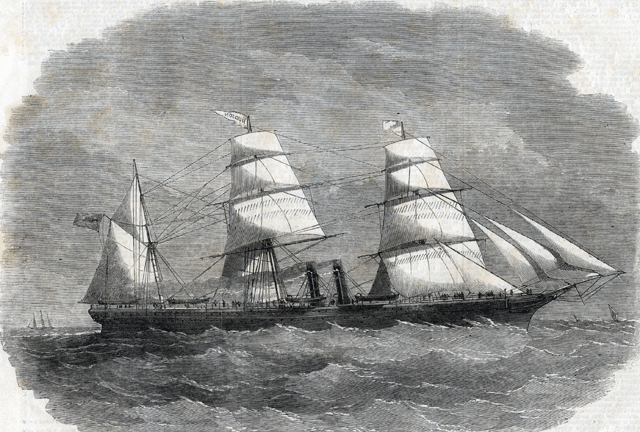
Heinrich Reddehase born Lehe 1850 deserted from the Konig Wilhelm in New York 5 November 1873.
15.10.1873 König Wilhelm I Nordd. Lloyd, Bremen Hirdes, J. New York 282 Abfahrtsdaten von Auswandererschiffen
The Konig Wilhelm 1st arrived in New York from Bremen on the 1st of November 1873 under Captain Joh Gerdes with 288 passengers, one death at sea. First class 27, second class 15.
Steam-ship Koenig Wilhelm I, (Ger.) Gerdes, Bremen October 15, and Southampton 18th with mdes and 288 passengers, NYTNote: I cannot find Heinrich Reddehase in either the crew lists or the registry.
Description of the Konig Wilhelm I;
The screw steamship " Konig Wilhelm I.," built and engined by Messrs. Caird and Co., of Greenock, for the North German Lloyd New Steam Line to tho West Indies, had her official trial trip on Saturday last, when she ran the measured mile at Skelmorlie at the rate of 12 knots per hour, at slow steam pressure, with 1,200 tons dead weight on board. She measures 2,450 tons (registers 1,69) tons), is 330 ft. in length, 39 ft. beam, and 31-ft depth from spar deck, and is fitted with engines of 350horse power. Accommodation is provided for 103 first-class passengers, 50 second, and 500 third, and she will carry from 1,800 to 2,000 tons of dead weight (fuel and cargo), her draught of water being about 20f t. when so loaded. The "Konig Wilhelm I." is the first of a new line of steamers on the eve of being started by the North German Lloyd to the West Indies, commencing at Bremen, calling at Southampton, and proceeding thence direct to Colon, Savanilla, Porto Cabello, La Guayra, and then back to Savanilla and Colon. At the last-named place the return voyage begins, only interrupted by calling at St. Thomas, the next ports being Cherborg, Southampton, and Bremen. The second vessel for this line, the " Kohn," was to have her trial daring the present week, and another, the "Graf Bismarck," is just launched. These steamers are built and fitted with special adaptation for the passenger and cargo traffic of the station on which they are to be placed. The " Konig Wilhelm I." leaves Greenock for Bremen on an early day.The Mechanics' magazine and journal of engineering 1870
Southampton July 28, 1873 the North German Lloyd's steam-ship Konig Wilhelm I from New York July 16 for Bremen.
Ran aground in Holland, Nov 11, 1873 while bound from Bremen to New York. Reportedly there was no loss of life.
SS Konig Wilhelm I (+1873) Wreck
Henry Blanck served on the MAIN from November 1870 to January 1871 and again from April 1871 to August 1871. See Henry Blanck at Sea
Abfahrtsdaten von Auswandererschiffen lists:
- 05.11.1870 Main Nordd. Lloyd, Bremen Oterendorp, K. von New York 355 passengers
- 29.04.1871 Main Nordd. Lloyd, Bremen Oterendorp New York 739 passengers
- 10.06.1871 Main Nordd. Lloyd, Bremen Oterendorp New York 704 passengers
- 29.07.1871 Main Nordd. Lloyd, Bremen Oterendorp New York 641 passengers
In 1869 there was a "race" from New York to Europe between the Main and the City of Parish:
THE ATLANTIC RECORDSNote I do not understand the dates.A similar race has just accidentally occurred between the City of Paris and the North German Lloyd screw steamship Main, Captain K. von Oterendorp. Both these magnificent vessels left New York on June 15, within an hour and a half of each other, the Inman steamer having the start. The City of Paris arrived off Queenstown 12.15 a. m. on the 15th. Queenstown is nearer to New York by about 280 miles, or 22 hours steaming, than Southampton, and the Main, had her destination been Queenstown, would have arrived at 1.15 p.m. on the 14th inst. As she left New York 1 hours later there was a result in her favour of l and a half hours over the celebrated Inman steamer. Neither company permits any racing, but every act of seamanship was doubtless exercised on board both vessels.
Engineering, Volume 51 By Design Council, May 1891
The steamship Main from Bremen arrived New York Feb 19 1870.
The steamship Main arrived in Southampton March 9, 1870.
The steamship Main arrived New York from Bremen April 8, 1870.
The steamship Main arrived from Bremen to New York July 1, 1870.
100 prominent members of the Odd Fellows of the Most Worthy Grand Sire of the Grand Lodger of the United States and their wives sailed for Bremen on the Steamship Main on July 15, 1870
The steamship Main from New York touched at Southampton March 7,1 1871.
In 1876 the MAIN sailed from Southampton to New York with £81,000 in gold coin and bars.
Collision between the Steamship Main and the schooner Seth M.Todd, 1881
The second marine wrestling match referred to took place last Saturday night, between the North German Lloyd steamship Main and the schooner Seth M. Todd, about 30 miles southeast of Fire Island. The Main had sailed from this port on that day, on her outward voyage, and the schooner was bound from Alexandria to Boston. The latter was almost completely wrecked, and the steamer put about and towed her to the Sandy Hook lightship, whence she was brought into port.Broken Shaft 1883The Insurance Times 1881
The steamship Main of the north German Lloyd left Hoboken at 2 on
an broke her shaft while crossing the andy Hook bar at 4:45.
A tug was sent to try and pull of the bar at high tide.
The Main was described as having fifty-six cabin passengers and
a considerable number of steerage
passengers as well as carrying a full cargo of
rye, tobacco, cotton and miscellaneous. "The Main is one of the oldest
vessels of the line. She was built in 1868."
(New York Tribune July 15, 1883).
MAIN 1868
The first MAIN was a 3,087 gross ton ship, built by Caird & Co, Greenock in 1868 for Norddeutscher Lloyd [North German Lloyd] of Bremen. Her details were - length 332ft x beam 40ft, clipper stem, one funnel, two masts, iron construction, single screw and a speed of 13 knots. There was passenger accommodation for 70-1st, 100-2nd and 600-3rd class. Launched on 22/8/1868, she sailed from Bremen on her maiden voyage to Southampton and New York on 28/11/1868. In 1878 her engines were compounded by the builders and on 6/3/1890 she commenced her last Bremen - New York voyage. On 6/3/1890 she started her final Bremen - Baltimore crossing and the following year was sold to British owners. She was destroyed by fire at Fayal, Azores on 23/3/1892. [North Atlantic Seaway by N.R.P.Bonsor, vol.2, p.546]
The MAIN made her final voyage to New York in 1890.

Roots web
Henry Blanck was on the NEW YORK from October 1868 through July 1870. Initially he was a "sculleryman" (a kitchen worker) but on his last trip he was a steward. See Henry Blanck at Sea for more information about the arrival and departures of the New York between 1868 and 1870.
Herman Blanck was on the NEW YORK in the fall of 1868 and the summer of 1869. He was a tonge (tunge). I do not know what it was. See Hermann Blanck At Sea
Abfahrtsdaten von Auswandererschiffen lists:
- 14.10.1868 New York Nordd. Lloyd, Bremen Dreyer, F. to New Orleans 155
- 02.01.1869 New York Nordd. Lloyd, Bremen Nordenholt to New York 359 passengers
- 20.02.1869 New York Nordd. Lloyd, Bremen Nordenholt to New York 298 passengers
- 28.04.1869 New York Nordd. Lloyd, Bremen Nordenholt, W. to New York 836 passengers
- 09.06.1869 New York Nordd. Lloyd, Bremen Himbeck, F. to New York 792 passengers
- 04.08.1869 New York Nordd. Lloyd, Bremen Nordenholt, W. to New York 383 passengers
- 10.11.1869 New York Nordd. Lloyd, Bremen Nordenholt to New Orleans 128 passengers
- 12.01.1870 New York Nordd. Lloyd, Bremen Nordenholt to New Orleans 29 passengers
- 13.04.1870 New York Nordd. Lloyd, Bremen Nordenholt to New York 577 passengers
- 16.06.1870 New York Nordd. Lloyd, Bremen Nordenholt to New York 425 passengers
- 05.11.1870 New York Nordd. Lloyd, Bremen Ludewigs to New Orleans 99 passengers
The Steamship New York Arrived from Bremen on January 18, 1869 (NYT)
Steamship New-York, (N. G.) Nordenholt, Bremen Jan 2 and Southampton Jan 5th, with mdse. and 374 passengers to Oelrichs & Co. Experienced strong westerly gales during first part of passage. Jan. 13 lat 46 56 lon 48 56 passed a Br. 4 master steamer bound E.The New York sailed for Bremen from New York on January 29, 1869 March 10 1869, New York Times: The Steamship New York from Bremen Feb 20 and Southampton Feb 23 reached New York March 9.
Passengers ArrivedThe Steamship New YorkMARCH 9.--In steamship New-York. from Bremen--Mr. and Mrs. Ostheim. S. and J. Colinfeld. Isaac Walker, Mr. and Mrs. J. Pickersgill, J. Negbaur, Miss Von Wyk. M. Bock, Charles Wilken and family, Ad. Bockelmann, Robert Unit W. I, Mrs. Cath. Hofen, George Spangerbing, W. Wigger, H. Wigger, Miss Clara Neirffer, T. Frankenthal, M. and T. Felsenheld, Miss Rose Felsenheld, J. Bamberger, Mrs. Freeman, Miss Breill, J Ward, Mr. Walker and family, M. J. Gough and family, Johan Streidbeck, Mr. Batte, J. Adams, W. Rabenstein, George Gilbert, David Howard, W. White, H. W. Stike, E. W. Philgard.
The NEW YORK of was built by Caird & Co, Greenock in 1858 for Norddeutscher Lloyd [North German Lloyd] and was a sister ship to the BREMEN. She was a 2,674 gross ton vessel, length 320ft x beam 39ft, clipper stem, one funnel, three masts (barque rigged for sail), iron construction, single screw and a speed of 10 knots. There was accommodation for 60-1st, 110-2nd and 400-3rd class passengers. Launched on 31st Mar.1858, she sailed from Bremen on her maiden voyage to New York on 14th Aug.1858. She made several sailings to Havana and New Orleans as well as the North Atlantic service, but commenced her final voyage for the company on 20th Dec.1873 when she sailed from Bremen for Southampton and New York. In 1874 she was sold to Edward Bates of Liverpool who removed the engines and used her as a sailing ship. On 20th Apr.1891 she was wrecked near Staten Island, NY. [North Atlantic Seaway by N.R.P.Bonsor, vol.2, p.544]
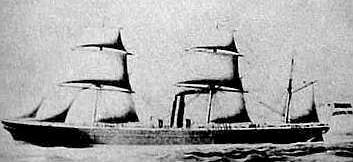
Two family members were connected to the WESER: Wilhelm Lange was a crew member and Julia Erxmeyer Lehmann and her daughter were passengers.
J. Wilhelm Lange born 1845 Rustof Germany J. Wilhelm Lange served as an "oberheizer" (Head stoker or fireman) on the WESER from September 5th 1870 to December 1870 (3 months and 7 days.) under Captain Wenke. He signed on the Weser again on April 11, 1872 and deserted in New York on April 28, 1872. Wilhelm Lange was the husband of Catherine Reddehase (the sister of Charlotte who married Fred Erxmeyer. See Fred Erxmeyer)
- No arrival of the Weser in New York in September 1870
- No arrival of the Weser in New York in October 1870
- Arrived Steam-ship Weser, (N. G.) Wenke, Bremen Nov 19 with mdse and 330 passengers to Oelrich & co, Nov 30 a 2P. M. passed Steam-ship Wesphalia, hence to Hamburg in lat 40 25 N lon 63 20, Dec. 1 at 5 A. M. at 40 20 N Lon 72 W passed an Inman steam-ship bound E, same date at A. M. passed two steamers bound E. signals not shown. Dec 2, 1870 NYT
- Cleared Steamship Weser (N. G.) Wenke, for Bremen Dec 17, 1870
- The Weser arrived in New York 26 April 1872 Capt Willegrod
with 749 passengers.
ARRIVED Stream-ship Weser (N. G.) Willigerod, Bremen april 13 via Southampton, 16th wid mdse, and 749 passengers to Oelich & Co.. Had light, variable winds mostley N. E. and westerly the entire passage; on the Banks covered sky, but little fog and a high S. W. rolling. April 22 lat 45.36, lon 47.5 passed bark Highland Mary (Br.) from Greenock for Savannah; 23d lat 45.18, lon 48.10 ship John Barbour, (Br.) bounr W.; 24th lat 42.55 lon 60.13 bark Alamon (N. G.) bound W. 25th, 219 miles off Sandy Hook, passed an Inmam steam-ship bound E.
Julia Erxmeyer Lehamnn passenger on the WESER March 29, 1873
Julia Erxmeyer Lehmann and her daughter "Julia" immigrated from Bremen through Southampton to New York on the Weser March 29, 1873.
The ship manifest shows 710 passengers with two infants born at sea. Captain Willigerod, 12 first class passengers, 21 Second class and the rest steerage.
"Arrived Steam-ship Weser (N. G.) Willigerod, Bremen March 15, via Southampton September 18 the with meds and 708 passengers to order"
The Weser sailed for Germany on April 6, 1873.
Abfahrtsdaten von Auswandererschiffen lists:
-
19.11.1870 Weser Nordd. Lloyd, Bremen Wenke to New York 335 passengers
- 13.04.1872 Weser Nordd. Lloyd, Bremen Willigerod to New York 725 passengers
- 15.03.1873 Weser Nordd. Lloyd, Bremen Willigerod to New York 700 passengers
WESER 1867
2,870 gross tons, length 325ft x beam 40ft, clipper stem, one funnel, two masts, iron construction, single screw and a speed of 11 knots. Accommodation for 60-1st, 120-2nd and 700-3rd class passengers. Built by Caird & Co, Greenock, she was launched for North German Lloyd on 19th Mar.1867. Maiden voyage Bremen - Southampton - New York started 1st Jun.1867. Fitted with compound engines by the builders in 1881 and started her last Bremen - New York - Baltimore sailing on 13th Jun.1895. She then started the first of two Bremen - South America sailings on 3rd Aug.1895 and was scrapped in 1896. [North Atlantic Seaway by N.R.P.Bonsor, vol.2,p.545]
In November 1867 the Weser, carrying 513 German passengers,
crossed from Southampton to New York in 9 days and three hours.
The Steamship Weser left Bremen February 19 and Southampton Feb 22 and reached New York early on March 5, 1870.
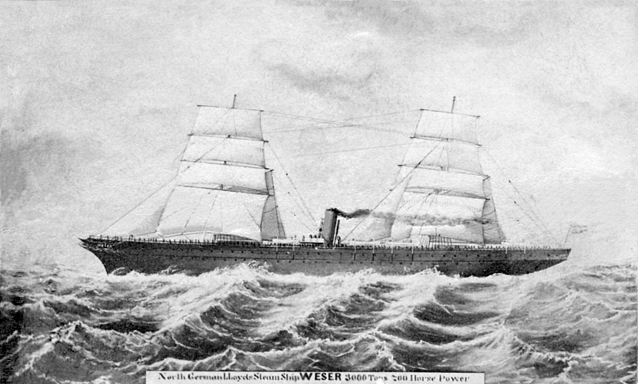
To see an additional image of the WESER go to Palmer List of Merchant Vessels
The WESER made her final voyage to New York in 1894.
